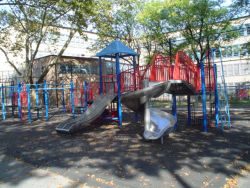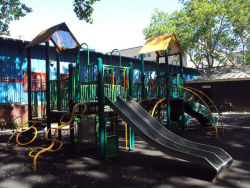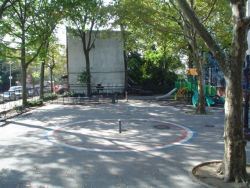Hilton White Playground
Hilton White Playground
What was here before?
Originally inhabited by the Lenape, this parcel was later part of Welsh merchant Richard Morris’s property. Morris purchased the land in 1670 from Samuel Edsall, who came to possess it after the death of the borough’s namesake, Jonas Bronck. The property was inherited by Gouverneur Morris, a founding father of the United States, in the late 18th century. His son ultimately divided the property for residential and commercial development, and this plot ended up as part of the estate of Henry P. De Graaf, founder of a furniture company. By the late 1800s the surrounding area was built up and a series of three- and four-story residences lined this block.
How did this site become a park?
Parks acquired this land between 1930 and 1932 to build a playground for the former P.S. 10 on Eagle Street. On September 23, 1936, the site opened and was known as Cauldwell Avenue Playground in honor of local baseball star and longtime public official William Cauldwell. This playground is near the site of the first recorded baseball game in Bronx history in 1853, when Cauldwell’s team, the Unions, defeated a team from Brooklyn, the Mutuals.
The playground was closed in 1958 for a year so that the old school could be demolished and P.S. 140 constructed. In 2000, the playground was improved, and today has swings, play equipment for various ages, and public bathrooms.
Who is this park named for?
This playground is named in honor of Hilton White (1932-1990), whose outreach and commitment to under-privileged athletes left a lasting impression on this Bronx community.
Born in Harlem in 1932, Hilton White attended Dewitt Clinton High School in the Bronx and graduated from Benedict College in South Carolina. After several years in military service, he returned home in the early 1960’s. NYC Parks hired him as a recreation supervisor at this location, where he founded a local basketball team called “the Falcons.”
As a coach and mentor to local kids, including professional player Nate “Tiny” Archibald, White emphasized excellence in school and on the court. Many of his players went on to play college basketball while they earned their degrees. As a result of his guidance, three players from the Falcons—Willie Worsley, Neville Shed and Willie Cager—received athletic scholarships to Texas Western University, where they played on the team that won the 1966 NCAA Finals. This game marked the first time a championship team started with an all-African American line-up, which happened to be playing against an all-white University of Kentucky team. The game spurred recruitment of Black players and coaches and increased the number of athletic scholarships for minorities.
On August 1, 2009, the site was rededicated Hilton White Playground to honor the role he played as educator and role model to children in Morrisania.
Check out your park's Vital Signs
Clean & Safe
Green & Resilient
Empowered & Engaged Users
Share your feedback or learn more about how this park is part of a
Vital Park System



